
When dealing with electronics you need 1 key thing, electricity. For quite a while now if I needed 5 volts I would just grab my homebrew arduino, but that is not always handy and its tethered to the pc and it does not have 3v. If I wanted 3 volts, now I am digging around looking for my UBW32 which does have 3v3 but now I have a 50$ microncontroller with very small regulators (so therefore only small loads) dangling around just for power, and its a mess.
So I need just a board that takes some DC from a wall wart and regulates it to usable voltages, and I set about to make it. This regulator board puts out +5, +3.3, variable and negative variable voltages, is pretty easy to make, and make a nice addition to the bench. (until I can get a real bench supply someday)
Now I know this is not ground breaking hackery, but I hope it helps someone out there, join us after the break to see what’s going on.
![]() First up, parts! I started by reviewing the datasheets for the 3 regulators, and pretty much throwing most of their advice away as most of this was scavenged parts. Beggars can’t be choosers.
First up, parts! I started by reviewing the datasheets for the 3 regulators, and pretty much throwing most of their advice away as most of this was scavenged parts. Beggars can’t be choosers.
That works mostly okay, but due to my resistance choices on the LM317T I am loosing a bit more (about an extra volt!) than I should be in the regulator. I used 100 ohms and 1khoms for the voltage adjustment … 120 and 2k or 240 and 5k would have been a much better choice, if I had those parts on hand.
But this is what I ended up using
1*SPST toggle switch
1*LED of your choice and appropriate resistor for 5 volt operation
3*Silicon rectifier diodes (I am using 1N4001’s but most would do fine)
2*47uf capacitors with voltage ratings higher than ~16 volts (I am using 50 volt caps)
1*10uf capacitor (its for the 3.3 volt line so anything more than 3v will work)
1*4.7uf capacitor (again I am using a 50 volt)
6*100nf ceramic capacitors (code 104)
2*100 ohm resistors
1*1k ohm resistor
1*1k ohm trimpot
1*7805 in a TO220 package
1*3 volt regulator in a TO220 package (I am using a ST “LD33V” though its not common)
1*LM317T in a TO220 package
1*555 timer
4*Dual terminal/ screw blocks
1*Large 3 position heatsink or 3 normal TO220 heatsinks
Wire, solder, and a 2 position jumper

More or less voltage comes in is filtered a bit with capacitors and is fed to the 7805 and 317T, the 3v3 regulator is wired to the output of the 7805 (along with the LED) so it does not have to drop a bunch of current and not run hot with minimal loads. Keeping in mind there are 2 regulators connected to a wall wart this thing in theory could suck up to 2.5 amps out of your supply so you either need a wall wart that can handle it or be very mindful of how much current you are drawing.
Next is the schematic .. not much to say here its a schematic… (click for large version)
Update: fixed the backwards diode
Finally I have to make the thing, I choose perf board with copper pads on one side, and uninsulated 22 gauge solid tinned copper as I find this way to be pretty easy as long as the layout is not too complicated.
Construction starts by mounting the regulators to the heat sink. I got this heat sink and many of the capacitors out of an old dead PC power supply. It is pretty big and should do the trick just fine, but there is a catch. Each of the regulators mounting tabs go to different functions, so unless I want to connect the outputs of the 3v3 regulator and the LM317T to the ground of the 7805 I am going to need either separate heat sinks or some silicon pads and nylon washer isolation hardware which my power supply was gracious enough to provide. (only after I threw them away and had to dig in the garbage for 20 min)
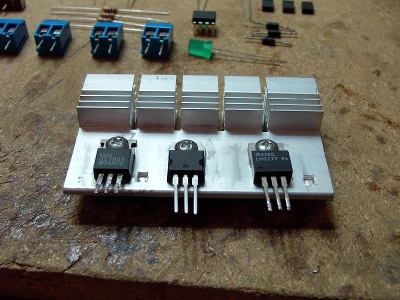

Here is a shot of the power input and 7805 all wired up and tested working.

Another shot with the 3v3 regulator wired up and tested working.
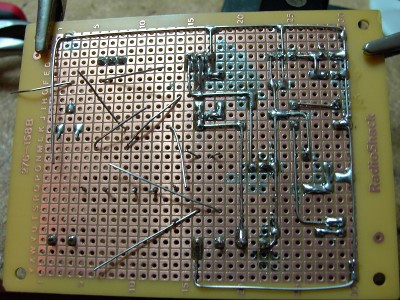
Another shot with the 317T wired up and tested working.
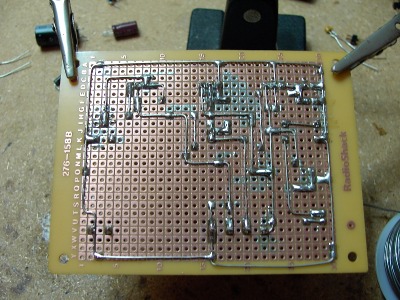
And finally the 555 voltage inverter is in place and working. While they make voltage inverters and I have a 5 volt one somewhere I rather like the idea of having one that can be hooked up to the 317 because I really don’t know if I will need -12, or -5 or anything in between.
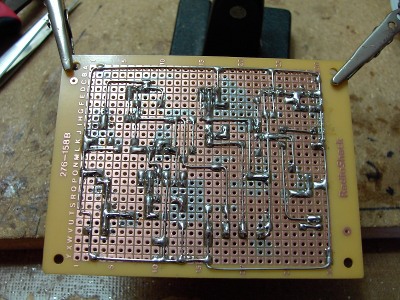
Keep in mind this is a kludgey way to make a negative voltage, and it will not be balanced with the positive output of the 317 (you loose 0.7 volts or more in the diodes). Also it takes a few seconds before it stabilizes on a voltage, so start low and stop a little short as it will continue rising for a few seconds. You might be able to minimize that by using a lower value capacitor on the 555’s output, right now I am using a 47uf but I have seen everything from 10 to 470 depending on which schematic your looking at.
Anyway here is the final product and I am ready to rock. You might notice a jumper block on there and that is to cut power going to the 317. With the losses due to my resistance choice and the 555 timers output, that part of the circuit draws about 37ma, the 7805, led, and 3v3 regulator only draws 36ma (20 for the led). So if you’re not using it why bother adding the additional load to your power supply? I may go back and tweak that.
Thanks for looking!
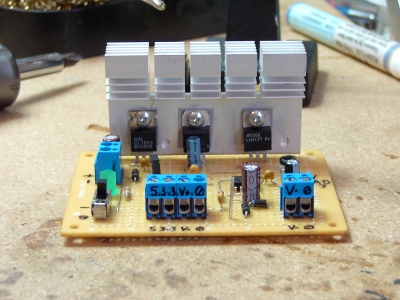
















Very interesting.
How do you calculate how much curent you can draw from the negative supply?
I like it, a simple multi and variable output out of cheap and easily source components.
Though is your output diode on the -ve supply the wrong way round? just I can only to get it to work in spice when the diode is that other way round.
To get less voltage drop through diodes you could use schottkys.
Or a trick I do is place a diode on the common or adjust led of the regulator to boost its output by the voltage drop of the diode, works with zeners too.
so you can make a 5V reg output 9.7V if you put a 4V7 zener on its common pin…though it does make it a bit warmer than usual
there seems to be a universal need for these. but good looking ones are expensive or the pc power supply route. but i think hackaday needs this as a featured project an opensource power supply . start with line /(or regulated for novice) power . then add on to the device modularity e.g. adjustable output with digital readout , current meter ,individual displays for each voltage output as adjusted to see right where you are . maybe even buttons to adjust voltage instead of pots any other ideas ? that just the superficial stuff i would want
This gives me a nice starting point for a project I’m playing with. Thanks!
i agree with neorazz, its a good bench for learning about electricity in general.
Thirded…
What might also be nice is to see if you can build the majority of it with scavenged components (dead PSU’s? we all have at least 2 lying around anyway)
In the schematic, are the 2 diodes facing the correct direction? For this to work, it seems like the diode between the 2 capacitors would need its anode, not its cathode, facing the output. I can’t quite see which direction it’s facing in the 2 photos, but I’m guessing it’s not as the schematic says?
Probably the most important feature of lab bench power supplies is adjustable current limiting. That’s not a feature of this design, but hopefully someone will consider adding it?
When you’re working with experimental circuitry on your bench, often mistakes are made. When that happens, if you’ve got a current limit and you’ve remembered to turn the knob relatively low, when you do make a mistake, the power supply never puts out too much current. That makes all the difference between blown parts or an “opps, glad the current limit saved me” moment.
RE: Paul
I believe the diode in series is with the -ve output is back to front on the schematic. the clamping diode is right though.
Nice, I think I’ll soon have to make something like that. Since I mess mostly with digital electronics I do not need negative supply and I’m mostly happy with such a device (usb powered, usually): http://necromant.ath.cx/wp/2011/03/14/the_dropper-2/
This would make a really great starter electronic kit if someone were to put together a parts list at some place like mouser, etc.
Tweeks
This looks like a cool project. I am genuinely curious though- why would you ever need such a power supply instead of just a PC power supply?
I put a power switch, power LED, rubber feet, and banana plugs for -5, 5, 3.3, and 12V on a discarded 300W power supply. All together it cost me about 2 hours and $0.00.
What is the benefit of a custom power supply?
what’s the benefit of anything custom? :-)
@hacknet- for me the reasons are:
*cost,
*making it specially adapted to my needs,
*Proving that I can / learning.
Only the third seems to fit in this case but the writeups don’t seem to be doing it just to learn how to do it.
Nice work.. simple, clean, and useful.
Good job documenting the design/build process as well. I always like to see someone explain why they chose the parts they did, and “this is what I had in the junk box” works for most projects.
That said, you *can* set set yourself up with a decent inventory of resistors without breaking the bank. Mouser sells quarter-watt 1% metal-film resistors for $2-3 per hundred. A few $20-30 orders on an at-need basis will set you up with enough parts for years of happy tinkering.
Got to admit, it’s re-inventing the wheel for me too unless I’m missing something. A Cheap PC PSU will supply multiple channels of all the common useful voltages at currents far in excess of what you might reasonably need, and you can get them out of dead machines or buy one new for £20 and mod it from there with a few banana sockets.
Consider that without an adjustable current limiter, an accident with a PC PSU can produce a boom/fire; whereas a linear reg will only produce a pop/smoke.
And should you blow out one voltage rail, a homebuilt power supply like this one can be easily repaired; whereas repairing a PC PSU is beyond many hobbyists’ abilities.
So there are some advantages to doing it this way.
Two simple and cheap improvements:
1) Add a LED & resistor to each supply rail, so that each LED receives the same current. You’ll be able to see at a glance whether something is drawing enough current to make a rail seriously sag, which may give you a chance to turn it off before something is damaged.
2) There are some terminals like the ones used here, but with springs instead of screws, which are more convenient. Sparkfun sells them. If you want a bunch, take a look at the datasheet to find the manufacturer. You can order samples direct from them for much less than Sparkfun prices, even including the shipping charges from China (but be aware it takes weeks, so stock up in advance).
My favorite thing to make. Sure, its “easier” to find a PC PS around, but its “easy” to buy something and not hack it, also.
Isnt that the point of hacking? Making it yourself, how you want, for your needs, the way you want it to look?
He’s created something he likes to look at, much like the hackers in Weird Science made something most guys like to look at.
Bravo!
I agree that an open source bench power supply project would be invaluable for beginners like me. While it’s true that a PC power supply is amply suitable as a bench supply for 3.3v, 5v, & 12v, eventually you’ll have to address power supply for projects that live away from your bench. For instance, I have a Pentax digital camera that requires 4.3v at the external power jack. In the spirit of DIY I refuse to buy a proprietary adapter and have made a project to build my own supply. My quest to learn the basics began here at http://digital-diy.com/General-Electronics/ac-dc-power-supplies-using-wall-warts.html
@chris-
All linear voltage regulators that I have used/seen have thermal protection and shut down when they overheat.
All PC power supplies that I have used for this purpose have over current protection and shut themselves off before I can fry anything.
@kanchoBlindside- Interesting. Aesthetics hadn’t occurred to me as a reason to design a bench top power supply.
you guys are correct about the last diode, it needs to be flipped around … I will correct it when I get home tonight, and if you see anything else please point it out
thanks!
never mind I went ahead and fixed it!
This is a nice build. I personally would have “hacked” a PC power supply instead of “making” a power supply from scratch. :)
Now if it only had a built in custom made clock.
Just kidding – nice project.
Another cheap, ready source of 5v supplies of varying current capabilities: Thrift store cell phone wall warts. You can pick them up for a buck or two. Some supply up to an amp. While you’re there, you’ll probably find (at least I do) other warts of varying voltages/currents/connectors.
Jack Dedert
It is tempting to work with wallwarts but
they are mostly rated for a specific charge that corresponds to the device. Thus, they might not output the correct voltage for your project.
Just take a DMM, measure a wallwart’s voltage with no loads and you will see that it’s a lot higher than specified. Also cheap wallwarts = cheap filtering, you might end with ripples everywhere.
Jons
i like it, very elegant and simple.
if you prototype a lot (read: mess of wires) with low power digital stuff, you can benefit from a 150~250mA PTC at output. just in case :P
Jons, very true, but much more easily remedied outboard than building an entire supply. Addding a bit of regulation or filtering after the faact (even onboard the specific project) is much easier than building an entire supply. What’s more, you may get lucky and find one which works perfectly for your particular application.
That said, I think the project shown is a very good exercise to understand how analog supplies work. A similar switchmode project would be interesting.
“My favorite thing to make. Sure, its “easier” to find a PC PS around, but its “easy” to buy something and not hack it, also.”
Not quite the same though is it, the PC power supply still needs hacking to some degree and is more capable. Buying a specific accurate, ripple free PS for bench work costs hundreds to thousands.
Dear Hackaday,
A perfect, thorough writeup. Nice project, but the details are all laid out, and the pictures are great. Thanks.